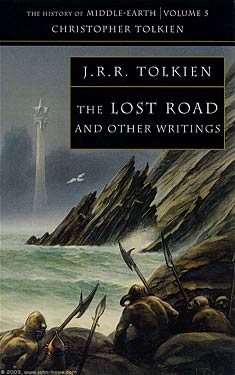JRR Tolkien
Completed 1/1/2017 Reviewed 1/3/2017
3 stars
This is volume 5 of the History of Middle Earth (HoME) Series. “The Lost Road” is Tolkien’s first writings
of the tales of Númenor. There are only
four chapters along with some fragments.
It was the product of a challenge Tolkien made with C.S. Lewis. Lewis was to write a space travel novel and
Tolkien was to write a time travel novel.
Lewis’ novel became “Out of the Silent Planet”. Tolkien’s book floundered, as did many of the
works he started, but the idea was that a philologist and his son travel back
through time to an Atlantis-like society.
Instead of being finished and published in its own right, story lived on
in the tales of Númenor, the kings of which Aragorn is descended from.
 One of the most interesting things about this is that Tolkien
had an obsession Atlantis. He had
recurring nightmares of the waves overtaking the land as it sank into the ocean. Little did he know, one of his sons had the
same recurring nightmare. So eventually,
the Atlantean myth made its way into Tolkien’s universe, as the tale of Númenor. The lives of humans on Númenor comprise the
second age. But the story is never
completely fleshed out. Even in the
published “Silmarillion” it is only about thirty pages of text (if I remember
correctly).
One of the most interesting things about this is that Tolkien
had an obsession Atlantis. He had
recurring nightmares of the waves overtaking the land as it sank into the ocean. Little did he know, one of his sons had the
same recurring nightmare. So eventually,
the Atlantean myth made its way into Tolkien’s universe, as the tale of Númenor. The lives of humans on Númenor comprise the
second age. But the story is never
completely fleshed out. Even in the
published “Silmarillion” it is only about thirty pages of text (if I remember
correctly).
In addition to “The Lost Road”, this volume contains the “The
Silmarillion” in the closest form it came to being published in the 1930s. The timing of it is interesting. Tolkien was writing this as “The Hobbit” was
being published, but just also as he was beginning to write his sequel, which
was to become “The Lord of the Rings”. You get the sense that at this time, “The
Hobbit” wasn’t connected yet to the rest of the mythology. This comes predominantly from Tolkien’s
discussion of dwarves. There seems to be
no correlation between the dwarves in “The Hobbit” compared to the dwarves,
particularly their creation, in “The Silmarillion”. Specifically, it is believed by the elven
author of “The Silmarillion” that dwarves have no soul. But anyone who has read “The Hobbit” could
successfully argue against this notion.
I give this book three out of five stars. I’m not giving it the standard four stars
because it was perhaps the toughest of the HoME books to read so far. Despite following along with The Tolkien
Professor’s podcasts of his textual analysis of the book, I found myself
confused by yet another version of these stories. I think that even being the fanboy that I am,
I found something missing, particularly in “The Silmarillion”. There’s a warmth that’s missing from the
published S (I’m just going to use the abbreviation now). This may sound weird to the people who didn’t
like the S, but there is something that I really got with the S upon my first
reading of it, the depth of the myths, perhaps.
This version, while fleshed out more than ever before, read more like a
history to me than a collection of mythological stories. This is perhaps because its writing came on
the heels of the Annals, which are also included in this book, and are very
much like a history book with names and dates.
So because of this, I knocked off a star. It’s still good for the fanboys and fangirls
out there, but a little heavier than the other books have been. I think I’m ready for the next book in the
series, the first of four books that documents the history of LOTR. It will be nice to get away from the S mythology for a little while.
No comments:
Post a Comment